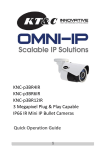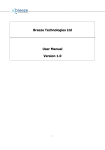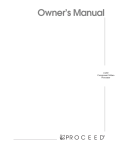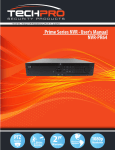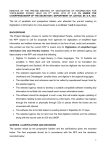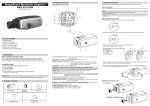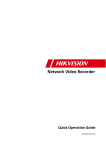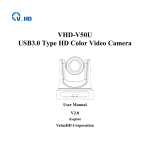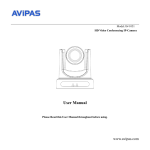Download KNR-p16Px16 - KT&C USA | KTNC
Transcript
KNR-p16Px16 KNR-p32Px16 Network Video Recorder Quick Installation Guide Quick Install Guide KNR-p16Px16 KNR-p32Px16 TABLE OF CONTENTS NVR Pre-Installation ....................................................................................................................................... 2 NVR Installation .............................................................................................................................................. 2 Hard Disk Installation ..................................................................................................................................... 2 Front Panel ....................................................................................................................................................... 2 Peripheral Connections ................................................................................................................................... 6 Wiring of Alarm Input ................................................................................................................................ 6 Wiring of Alarm Output ............................................................................................................................. 6 Using of Alarm Connectors ........................................................................................................................ 6 Controller Connection ................................................................................................................................ 7 Specifications .................................................................................................................................................... 8 HDD Storage Calculation Chart ................................................................................................................... 11 Accessing by Web Browser ............................................................................................................................ 12 Logging In................................................................................................................................................ 12 Live View ................................................................................................................................................. 12 Recording ................................................................................................................................................. 13 Playback ................................................................................................................................................... 15 Log ....................................................................................................................................................... 16 Menu Operation ............................................................................................................................................. 17 Menu Structure......................................................................................................................................... 17 Startup and Shutdown .............................................................................................................................. 17 Live View ................................................................................................................................................. 18 Adding IP Cameras .................................................................................................................................. 18 Recording ................................................................................................................................................. 20 Instant Recording ............................................................................................................................. 21 All-day Recording ............................................................................................................................ 21 Playback ................................................................................................................................................... 21 Backup ..................................................................................................................................................... 22 1 Quick Install Guide KNR-p16Px16 KNR-p32Px16 Thank you for purchasing our product. If there is any question or request, please do not hesitate to contact dealer. This manual is applicable to the models listed in the following table. Series Model Type Omni IP KNR-p16Px16 Network Video Recorder KNR-p32Px16 NVR Pre-Installation These Omni IP series KNR-p16Px16 and KNR-p32Px16 NVRs are highly advanced surveillance equipment that should be installed with care. Please take into consideration the following precautionary steps before installation of the NVR. 1. Keep all liquids away from the NVR. 2. Install the NVR in a well-ventilated and dust-free area. 3. Ensure environmental conditions meet factory specifications. 4. Install a manufacturer recommended HDD. NVR Installation During the installation of the NVR: 1. 2. 3. 4. 5. 6. 7. 8. Use brackets for rack mounting. Ensure there is ample room for audio and video cables. When routing cables, ensure that the bend radius of the cables are no less than five times than its diameter. Connect both the alarm (if used) and LAN/WAN cables. Allow at least 2cm (≈0.75-inch) of space between racks mounted devices. Ensure the NVR is grounded. Environmental temperature should be within the range of -10 ºC ~ 55 ºC, 14ºF ~ 131ºF. Environmental humidity should be within the range of 10% ~ 90%. Hard Disk Installation Before you start: Disconnect the power from the NVR before installing a hard disk drive (HDD). A factory recommended HDD should be used for this installation. Up to 4 SATA hard disks can be installed on your NVR; or 2 SATA HDD plus optional DVD-RW. Tools Required: Screwdriver. Front Panel KNR-p16Px16 and KNR-p32Px16 No. 1 2 3 4 Name POWER ON/OFF USB Interface IR Receiver POWER Function Description Power on/off switch. Connect to USB mouse or USB flash memory. Receiver for IR remote control. Power indicator lights in green when NVR is powered up. 2 Quick Install Guide KNR-p16Px16 KNR-p32Px16 READY STATUS 5 ALARM HDD Tx/Rx DVD-ROM DIRECTION 6 ENTER SHIFT 1/MENU 2ABC/F1 3DEF/F2 7 4GHI/ESC 5JKL/EDIT 6MNO/PLAY 7PQRS/REC 8TUV/PTZ Ready indicator is normally green, indicating that the NVR is functioning properly. Indicator turns green when NVR is controlled by an IR remote control with the address from 1~254; Indicator turns red when the SHIFT button is used; Indicator does not light when the NVR is controlled by a keyboard or by the IR remote control with the address of 255; Indicator turns green when the NVR is controlled by IR remote control (with the address from 1~254) and keyboard at the same time , and the SHIFT button is not used; Indicator turns orange : (a) when the NVR is controlled by IR remote control (with the address from 1~254) and keyboard at the same time and the SHIFT button is used as well; (b) when the NVR is controlled by IR remote control (with the address from 1~254) and the SHIFT button is used. Alarm indicator turns red when a sensor alarm is detected. HDD indicator blinks in red when data is being read from or written to HDD. TX/RX indictor blinks in green when network connection is functioning properly. Slot for optional DVD-RW (replaces 2 HDD). The DIRECTION buttons are used to navigate between different fields and items in menus. In Playback mode, the Up and Down button is used to speed up and slow down recorded video. In All-day Playback mode, the Left/Right button can be used to select the recorded video of next/previous day; in Playback by Normal Video Search, the Left/Right button can be used to select the next/previous recorded file. In Live View mode, the directional buttons can be used to cycle through channels. In PTZ control mode, it can control the movement of the PTZ camera. Confirm selection in any of the menu modes. It can also be used to tick checkbox fields. In Playback mode, it can be used to play or pause the video. In Single-frame Playback mode, pressing the ENTER button will advance the video by a single frame. In Auto-switch mode, it can be used to stop /start auto switch. Switch of compound keys between the numeric/letter input and functional control. Enter numeral “1”; Access the main menu interface. Enter numeral “2”; Enter letters “ABC”; The F1 button can be used to select all items on the list; In PTZ Control mode, the F1 button can be used to zoom out (zoom-) the PTZ camera; In live view or playback mode, the F1 button can be used to switch between main and spot video output. Enter numeral “3”; Enter letters “DEF”; In PTZ Control mode, the F1 button can be used to zoom in (zoom+) the PTZ camera; The F2 button can be used to cycle through tab pages. Enter numeral “4”; Enter letters “GHI”; Exit and back to the previous menu. Enter numeral “5”; Enter letters “JKL”; Delete characters before cursor; Select the checkbox and ON/OFF switch; Start/stop record clipping in playback. Enter numeral “6”; Enter letters “MNO”; In Playback mode, it is used for direct access to playback interface. Enter numeral “7”; Enter letters “PQRS”; Manual record, for direct access to manual record interface; manually enable/disable record. Enter numeral “8”; 3 Quick Install Guide KNR-p16Px16 KNR-p32Px16 9WXYZ/PREV 0/A 8 JOG SHUTTLE Control Enter letters “TUV”; Access PTZ control interface. Enter numeral “9”; Enter letters “WXYZ”; Multi-camera display in live view; In Playback mode or MenuPlaybackTag playback interface, this button can be used to delete the selected tag. Enter numeral “0”; Switch between input methods (upper and lowercase alphabet, symbols and numeric input). In Playback mode, this button can be used to add the default tag. Move the active selection in a menu. The inner ring will move the selection up and down; the outer ring will move it left and right. In Playback mode, the inner ring is used to jump 30s forward/backward in video files. The outer ring can be used to speed up/slow down the video. In Live View mode, it can be used to cycle through different channels. In PTZ control mode, in can control the movement of the PTZ camera. 4 Quick Install Guide KNR-p16Px16 KNR-p32Px16 Rear Panel KNR-p16Px16 and KNR-p32Px16 No. Item Description 1 VIDEO OUT BNC connector for video output. 2 CVBS AUDIO OUT BNC connector for audio output. This connector is synchronized with CVBS video output. VGA AUDIO OUT BNC connector for audio output. This connector is synchronized with VGA video output. 3 LINE IN BNC connector for audio input. 4 RS-232 Interface Connector for RS-232 devices. 5 VGA DB15HD connector for VGA output. Display local video output and 6 HDMI HDMI video output connector. Includes HDMI audio support. 7 eSATA (Optional) Connects external SATA HDD, CD/DVD-RM. 8 LAN Interface One 10/100/1000 RJ45 Ethernet interface 9 Termination Switch RS-485 termination switch. menu. Up position is not terminated. Down position is terminated with 120Ω resistance. RS-485 Interface Connector for RS-485 devices. T+ and T- pins connect to R+ and Rpins of PTZ receiver respectively. D+, D- pin connects to Ta, Tb pin of controller. For cascading devices, 10 Controller Port the first NVR’s D+, D- pin should be connected with the D+, D- pin of the next NVR. ALARM IN Connector for alarm inputs. ALARM OUT Connector for alarm outputs. 11 GROUND Ground (recommended to be connected when NVR starts up). 12 AC 100V ~ 240V AC 100V ~ 240V power supply. 13 POWER Switch for turning on/off the NVR 14 USB interface Universal Serial Bus (USB) ports for additional devices such as USB mouse and USB Hard Disk Drive (HDD). 15 Network Interfaces with 16 Plug-and-Play network interfaces for the cameras and to provide PoE function Power over Ethernet. 5 Quick Install Guide KNR-p16Px16 KNR-p32Px16 Peripheral Connections Wiring of Alarm Inputs The alarm input is an open/closed relay. To connect the alarm input to the device, use the following diagram. If the alarm input is not an open/close relay, please connect an external relay between the alarm input and the device. Wiring of Alarm Output To connect to an alarm output (AC or DC load), use the following diagram: DC Load Connection Diagram AC Load Connection Diagram For DC load, the jumpers can be used within the limit of 12V/1A safely. To connect an AC load, jumpers should be left open (you must remove the jumper on the motherboard in the NVR). Use an external relay for safety (as shown in the figure above). There are 4 jumpers (JP1, JP2, JP3, and JP4) on the motherboard, each corresponding with one alarm output. By default, jumpers are connected. To connect an AC load, jumpers should be removed. Example: If you connect an AC load to the alarm output 3 of the NVR, then you must remove the JP 3. Using of Alarm Connectors To connect alarm devices to the NVR: 1. Disconnect pluggable block from the ALARM IN /ALARM OUT terminal block. 2. Unfasten stop screws from the pluggable block, insert signal cables into slots and fasten stop screws. Ensure signal cables are in tight. 6 Quick Install Guide KNR-p16Px16 KNR-p32Px16 3. Connect pluggable block back into terminal block. Controller Connection To connect optional controller to the NVR: 1. Disconnect pluggable block from the KB terminal block. 2. Unfasten stop screws from the KB D+, D- pluggable block, insert signal cables into slots and fasten stop screws. Ensure signal cables are in tight. 3. Connect Ta on controller to D+ on terminal block and Tb on controller to D- on terminal block. Fasten stop screws. 4. Connect pluggable block back into terminal block. Make sure both the controller and NVR are grounded. 7 Quick Install Guide KNR-p16Px16 KNR-p32Px16 Specifications KNR-p16Px16 KNR-p32Px16 16 16 32 16 Streaming Video Inputs & Recording Maximum Number of IP Cameras Number of built in PnP/PoE Switch Ports Supported Live View/ Record Resolutions 5MP / 3MP / 1080P / UXGA / 720P / VGA / 4CIF / DCIF / 2CIF / CIF / QCIF Sub-stream Audio streaming Maximum FPS rate per camera (Live and Record) Supported for recording, playback and live viewing Supported from audio capable cameras 30FPS Main stream; 30FPS 30FPS Main stream; 30FPS Sub-stream Sub-stream Up to 480FPS total for 16 cameras Up to 960FPS total for 32 cameras Maximum Record Streaming Video Input Bandwidth (all cameras combined) Recording Compression 80Mb/s 160 Mb/s Depends on IP Camera; typically H.264 for main stream, MJPEG for sub-stream Recording Modes Continuous, Motion, Alarm, Motion+Alarm, Motion or Alarm Motion Detection Camera Side, configurable from NVR for KNC-p3 Omni IP Series Cameras Schedule Period Per day in 1 hour blocks; or 8 time periods per day, each with different record mode; plus holidays Pre- and Post- Event Recording Pre-record 0~30 seconds; post record 5s~10 minutes Built in network switch port speed KT&C Omni-IP 'hands free Plug and Play' Cameras Fully Supported Third Party Cameras Supported (requires traditional configuration and setup) 10/100 Mb/s each port KNC-p3BR4IR, KNC-p3BR6IR, KNC-p3BR12IR, KNC-p3DR4IR, KNC-p3DR3IR,KNC-p3DR6IR, KNC-p3DR12IR, KNC-p3BR4XIR, KNC-p3BR6XIR, KNC-p3BR12XIR, KNC-p3TR4XIR, KNC-p3TR3XIR, KNC-p3TR6XIR, KNC-p3LR4IR, KNC-p3LR3IR, KNC-p3LR6IR, KNC-p3BR28V12IR, KNC-p3DR28V12IR Onvif; Acti, Arecont, Axis, Bosch, Brickcom, Canon, Hikvision, Hunt, Panasonic, Pelco, Samsung, Sanyo, Sony, Vivotek, Zavio Local Live Presentation of Streaming Video/Audio HDMI 60Hz: 1920×1080, 1600×1200, 1280×1024, 1280×720, 1024×768 Local Display Main Monitor Outputs Camera Display Layouts Multiple Independent Monitors VGA 60Hz: 1920×1080P, 1600×1200, 1280×1024, 1280×720, 1024×768 BNC/CVBS (1.0V p-p, 75 Ω) 704 × 480 (NTSC) 1, 2x2, 1+5, 1+7, 3x3, 4x4, 1, 2x2, 1+5, 1+7, 3x3, 4x4 5x5, 32, 6*6 HDMI and VGA monitors can be duplicates, or display independent live and/or playback screens; CVBS is independent and can function as a call or auxiliary monitor 8 Quick Install Guide KNR-p16Px16 KNR-p32Px16 Single camera view and 2x2 at main stream resolution; Automatic switching to sub-stream resolution in >4 cameo multi-view display to conserve CPU capacity and maintain parity between per-camera screen area and image size Automatic Stream Selection Audio Output (requires audio equipped cameras) 2-ch Line Level, BNC (Linear, 600Ω), one synched to CVBS, one synched to VGA; HDMI audio on HDMI monitor output Playback of Recorded Video/Audio Supported Playback Resolutions 5MP / 3MP / 1080P / UXGA / 720P / VGA / 4CIF / DCIF / 2CIF / CIF / QCIF Local Display Playback Maximum Video Bandwidth (all cameras combined) ~32Mb/s nominal Nominal Local Playback Capability (actual playback depends on decoding load which varies based on settings for recorded video bandwidth restrictions, resolution, image quality, FPS rate, 8 channels @ 1920x1080; 16 channels @ 1280x720 (based on average per channel bandwidth of ~4Mb/s@1080p and ~2Mb/s @ 720p) Reduced total bandwidth permits greater number of cameras to be played. compression efficiency, and complexity of pixel change in the scene) Playback search modes Playback Controls Time/Date; Alarm (motion or other source); Manual Tags; Smart Search for motion events from recorded video Play; Pause; Forward/Reverse; speed control for single~1.8~16X; Slide bar with overview of record type and snapshot display from slider position Digital Zoom During Playback Supported on Local Displays and CMS Local Hard Drives and Other Storage Number of Internal Hard Drives Up to 4 SATA HDD; up to 4TB each for 16TB maximum Mirror Recording Can clone pairs of disks S.M.A.R.T With extensive statistics, alarms, on demand tests and reporting Optional DVD-RW Replaces 2 HDD, limiting internal storage to 8TB maximum External HDD one eSATA Interface Record to HDD, eSATA, NAS or SAN Archive to USB, HDD, eSATA, NAS or SAN Local Plug and Play Camera Network Support Integral PoE Switch Camera Network Security 16 Ports 10/100 Mb/s Option to enable pass though access from LAN/WAN to cameras, or to isolate camera network from LAN/WAN for increased security PoE Type 802.3at Max 30W per port Total Power Budget PnP Network Support (Using KT&C KNC-p3 Omni-IP Series cameras connected to internal PnP PoE switch ports) 200W all ports Integral DHCP function with address-per-port initial assignment Internal bridge can forward connections from LAN/WAN network port to individual IPC for remote access to IPC OSD detail configuration menus 9 Quick Install Guide KNR-p16Px16 KNR-p32Px16 Remote Viewing and Local/Remote Configuration Built in Web Server Interface Live view, playback and configuration via IE, Chrome, Firefox, Safari (with free plug-in/extension installed) CMS PC and MAC Client supports multiple device viewing, playback (with digital zoom) and configuration; user rights per camera; E-map support; live view up to 64 cameras in 4:3 and 48 cameras in 16:9; up to 16 cameras in playback Mobile Apps iOS and Android supported ; live 1 & 4 camera views; single camera playback; snapshots from live or play; copy clips/record to smartphone; audio support; PTZ control. HD version of app, optimized for tablets, is available User Rights Control Event Logging Per user-per camera for multiple functions Multiple types: alarm, exception, operation, information; dozens of sub-types within each major type Firmware Upgrade Backup/Restore Configuration From USB or remotely For NVR settings and for IP Camera settings; from USB or remotely Network and Other Interfaces LAN/WAN Network Port Connection of non-PnP IP cameras Remote Monitoring Output Maximum Bandwidth One 10/100/1000Mb/s RJ-45 port Supported 240Mb/s Maximum number of remote connections DST/NTP Port Mapping/uPnP Serial Interfaces 160Mb/s 128 Supported; choice of time zone, NTP server, DST start/end/offset Automatic port forwarding/redirection using uPnP on routers with this capability 1xRS-232 DB9; 1xRS-485; 1xKeyboard controller input USB 2.0 Interfaces 2 front; 1 rear Audio Input 1 BNC Alarm Inputs 16 Alarm Outputs 4 single pole General Mechanical and Environmental Power Input Continuous Power Consumption 100~240VAC, up to 300W max. continuous/450W peak, 50~60Hz; USA Power Cord Up to 40W for NVR; up to 200W for Up to 45W for NVR; up to 200W for PoE PoE Operating Temperature 14°F ~ 131°F (-10°C ~ +55°C) Operating Humidity Range 10% ~ 90% Cooling Fan 1, in power supply 10 Quick Install Guide KNR-p16Px16 KNR-p32Px16 1.5U Rack mountable chassis (rack ears provided) 17.52" x 15.35" x 2.76" (445mm x 390mm x 70mm) Size Weight (without hard drives or ODD) 8.8 lb./4 Kg allow ~1.4 lb. per HDD Certifications FCC, CE, RoHS HDD Storage Calculation Chart The following chart shows an estimation of storage space used based on recording at one channel for an hour at a fixed bit rate. Bit Rate 96K 128K 160K 192K 224K 256K 320K 384K 448K 512K 640K 768K 896K 1024K 1280K 1536K 1792K 2048K Storage Used 42M 56M 70M 84M 98M 112M 140M 168M 196M 225M 281M 337M 393M 450M 562M 675M 787M 900M 4096K 1800M 8192K 3600M 16384K 7200M Please note that supplied values for storage space used is just for reference. The storage values in the chart are estimated by formulas and may have some deviation from actual value. 11 Quick Install Guide KNR-p16Px16 KNR-p32Px16 Accessing by Web Browser Logging In You can get access to the device via web browser. Open web browser, input the IP address of the device and then press Enter. The login interface appears. Input the user name and password, and click the Login button. The default IP address is 192.0.0.64. The default user name is admin, and password is 12345. You may use one of the following listed web browsers: Internet Explorer 6.0, Internet Explorer 7.0, Internet Explorer 8.0, Internet Explorer 9.0, Internet Explorer 10.0, Apple Safari, Mozilla Firefox, and Google Chrome. The supported resolutions include 1024*768 and above. When you log in for the first time, the system will remind you to install the Plug-in control. After the installation, you can configure and manage the device remotely. Live View The live view interface appears by default when you log in the device. 12 Quick Install Guide KNR-p16Px16 KNR-p32Px16 Interface Introduction No. Name Description Displays the list of channels and the playing and recording status of each channel. Channel List 1 The stream type can be switched by clicking the icon before the channel name: stands for main stream and for sub-stream. 2 Live View Window Displays the image of channel, and multi-window division is supported. 3 Play Control Bar Play control operations are supported. Pan, tilt, zoom operations are supported, as well as preset and patrol editing PTZ Control 4 and calling. PTZ function can only be realized if the connected camera supports PTZ control. Video Parameters 5 Configuration Brightness, contrast, saturation and hue of the image can be edited. Start Live View Steps: 1. In the live view window, select a playing window by clicking the mouse. 2. Double click a camera from the device list to start the live view. 3. You can click the button on the toolbar to start the live view of all cameras on the device list. Refer to the following table for the description of buttons on the live view window: Icon Description Icon Select the window-division mode / / Start/Stop all live view / Capture pictures in the live view Start/Stop all recording / Previous/Next page Open/Close audio Start/Stop two-way Audio Adjust volume mode / Description / Enable/Disable digital zoom Full screen Recording Before you start Make sure the device is connected with HDD or network disk, and the HDD or network disk has been initialized for the first time to use. Two recording types can be configured: Manual and Scheduled. The following section introduces the configuration of scheduled recording. Steps: 1. Click Remote Configuration> Camera Settings> Record Schedule to enter Record Schedule settings interface. 2. Select the camera to configure the record schedule. 13 Quick Install Guide KNR-p16Px16 KNR-p32Px16 3. Check the checkbox of Enable Schedule to enable recording schedule. 4. Choose the day in a week to configure scheduled recording. 5. Click Edit to edit record schedule. 1) Configure All Day or Customize Record: If you want to configure the all-day recording, please check the All Day checkbox. If you want to record in different time sections, check the Customize checkbox. Set the Start Time and End Time. Up to 8 segments can be configured and each segment cannot be overlapped. 2) Select a Record Type. The record type can be Continuous, Motion, Alarm, Motion & Alarm, Motion | Alarm and VCA. 3) Check the checkbox of Select All and click Copy to copy settings of this day to the whole week. You can also check any of the checkboxes before the date and click Copy. 4) Click OK to save the settings and exit the Edit Schedule interface. 6. Click Advanced to configure advanced record parameters. 7. Click Save to validate the above settings. 8. (Optional) You can click the Copy to… button to copy the same setting to other cameras. 14 Quick Install Guide KNR-p16Px16 KNR-p32Px16 Playback Interface Introduction No. Name Description 1 Channel List Displays the list of channels and the playing status of each channel. 2 Playback Window Displays the image of channel. 3 Play Control Bar Play control operations are supported. 4 Time Line Displays the time bar and the records marked with different colors. 5 Playback Status Displays the playback status, including channel number and playback speed. 6 Calendar You can select the date to play. Start Playback Steps: 1. Click Playback on the menu bar to enter playback interface. 2. Click the camera from the device list for playback. 3. Select the date from the calendar and click Search. 4. Click the 5. Use the buttons on the toolbar to operate in playback mode. button to play the searched video file on the current date. Playback Control Buttons Description Area Description / Play/Pause Stop Slow down Speed up Play by single frame Capture Stop all playback Download / Area Video clip / 15 Description Open/Close audio Quick Install Guide KNR-p16Px16 KNR-p32Px16 Area 6. Description Area Description Full screen Transcoded playback Reverse playback Window division You can drag the progress bar with the mouse to locate the exact playback point. You can also input the time in the textbox and click button to locate the playback point. The color of the video on the progress bar stands for the different video types. To play back recording files from different channel, you may set the window division mode by clicking the button and choose a window, and then repeat the above steps 2-4. Transcoded Playback Purpose: To save the bandwidth cost, the transcoded playback can be adopted. Steps: 1. Make sure the playback of current channel is stopped. 2. Move the mouse to the icon and edit the required parameters for transcoded playback, including Resolution, Bitrate, and Frame Rate. 3. Click the button, if it turns to , then the trancoding process is compeleted. 4. Click the button to start transcoded playback. Log You can view and export the log files at any time, including operation, alarm, exception and information of device. Before you start: The Log function can be realized only when the device is connected with HDD or network disk. Steps: 2. Click Log on the menu bar to enter the Log interface. 3. Set the log search conditions to refine your search, including the Major Type, Minor Type, Start Time and End Time. 4. Click the Search button to start searching log files. 5. The matched log files will be displayed on the list. Up to 2000 log files can be found each time, and 100 log files can be displayed on each page. You can click the button to save the searched log files to local directory. 16 Quick Install Guide KNR-p16Px16 KNR-p32Px16 Menu Operation Menu Structure Startup and Shutdown Proper startup and shutdown procedures are crucial to expanding the life of the NVR. To start your NVR: 1. Check the power supply is plugged into an electrical outlet. It is HIGHLY recommended that an Uninterruptible Power Supply (UPS) be used in conjunction with the device. 2. Press the POWER button on the rear panel. The Power LED should turn green. The unit will begin to start. After the device starts up, the wizard will guide you through the initial settings, including modifying password, date and time settings, network settings, HDD initializing, and recording. To shut down the NVR: 1. Enter the Shutdown menu. Menu > Shutdown 2. Select the Shutdown button. 3. Click the Yes button. 17 Quick Install Guide KNR-p16Px16 KNR-p32Px16 Live View Some icons are provided on screen in Live View mode to indicate different camera status. These icons include: Live View Icons In the live view mode, there are icons at the upper-right corner of the screen for each channel, showing the status of the record and alarm in the channel, so that you can find problems as soon as possible. Alarm (video loss, tampering, motion detection or sensor alarm) Record (manual record, schedule record, motion detection or alarm triggered record) Alarm & Record Event/Exception (event and exception information, appears at the lower-left corner of the screen.) Adding IP Cameras You should add and configure the online IP cameras to enable the live view and recording function. Steps: 1. Right-click the mouse when you in the live view mode to show the right-click menu. 2. Select Add IP Camera in the pop-up menu to enter the IP Camera Management interface. 18 Quick Install Guide KNR-p16Px16 KNR-p32Px16 3. The online cameras with same network segment will be displayed in the camera list. Click the add the camera. button to Or you can click the One-couch Adding button to add all the online IP cameras. The added camera is marked in white while the camera has not been added is marked in yellow. Explanation of the icons Icon Explanation Icon Edit basic parameters of the camera Explanation Add the detected IP camera. The camera is disconnected; you can The camera is connected. click the icon to get the exception information of camera. Delete the IP camera 4. Advanced settings of the camera. To add other IP cameras: 1) Click the Custom Adding button to pop up the Add IP Camera (Custom) interface. 19 Quick Install Guide KNR-p16Px16 KNR-p32Px16 2) You can edit the IP address, protocol, management port, and other information of the IP camera to be added. 3) Click Add to add the camera. 4) (For the encoders with multiple channels only) check the checkbox of Channel No. in the pop-up window, as shown in the following figure, and click OK to finish adding. Recording Before you start: Make sure that the HDD has already been installed. If not, please install a HDD and initialize it. You may refer to the user manual for detailed information. Purpose: Two kinds of record types are introduced in the following section, including Instant Record and All-day Record. And for other record types, you may refer to the user manual for detailed information. After rebooting all the manual records enabled are canceled. 20 Quick Install Guide KNR-p16Px16 KNR-p32Px16 Instant Recording On the live view window of each channel, there is a quick setting toolbar which shows on the bottom of the window when you click on it. Click the icon to enable the record, and the icon turns to then the icon turns to . And click icon to disable the record, . All-day Recording Steps: 1. On the live view window, right lick the window and move the cursor to the Start Recording option, and select Continuous Record or Motion Detection Record on your demand. 2. And click the Yes button in the popup Attention message box to confirm the settings. Then all the channels will start to record in the selected mode. Playback Play back the record files of a specific channel in the live view menu. Channel switch is supported. Option 1: Choose a channel under live view using the mouse and click the button in the shortcut operation menu. Only record files recorded during the past five minutes on this channel will be played back. Option 2: Steps: 1. Enter the Playback menu. 21 Quick Install Guide KNR-p16Px16 KNR-p32Px16 Mouse: right click a channel in live view mode and select Playback from the menu. Front Panel: press PLAY button to play back record files of the channel under single-screen live view. Under multi-screen live view, record files of the selected channel will be played back. Pressing numerical buttons will switch playback to related channels during playback process. 2. Playback management. The toolbar in the bottom part of Playback interface can be used to control playing process. Just check the channel or channels if you want to switch playback to another channel or execute simultaneous playback of multiple channels. Backup Recorded files can be backed up to various devices, such as USB flash drives, USB HDDs or a DVD writer. Steps: 1. Enter Video Export interface. Choose the channel(s) you want to back up and click on the Quick Export button. 22 Quick Install Guide KNR-p16Px16 KNR-p32Px16 2. Enter Export interface, choose backup device and click Export button to start exporting. 3. Check backup result. Choose the record file in Export interface and click button 23 to check it.

























